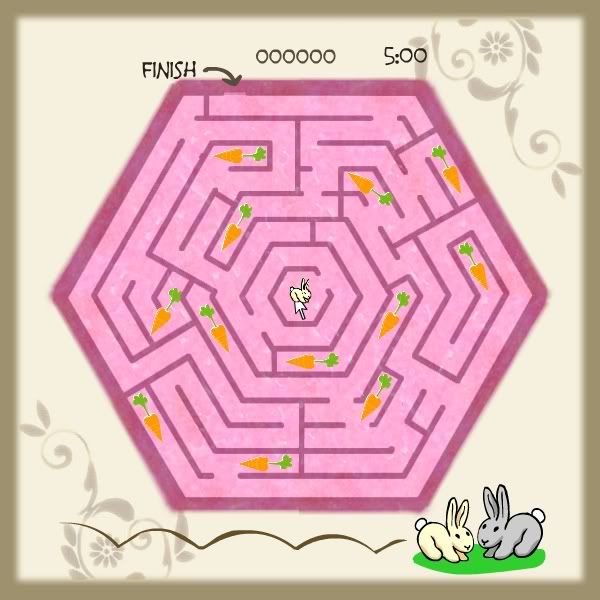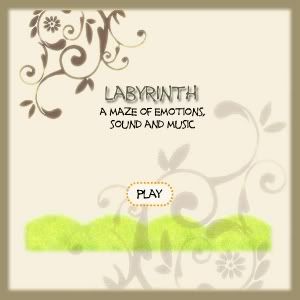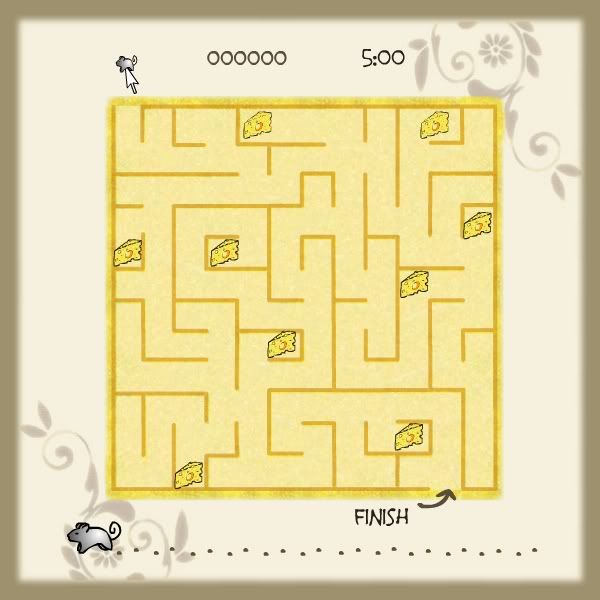

Wednesday, May 31, 2006
- Difficulty in games
There are 2 ways of incorporating varying difficulty levels in games. One is to prompt users to choose "easy", "medium", "hard" before beginning play and the other is to include many tasks or levels of varying difficulty within the same game. Based on my own research about games in general, gamers have complained that that there are no options allowing them to choose the level of difficulty in many games and that frustrates them. But with this comes the problem of determining the differences between what goes on in the easy level and the other levels. Some complained that in some games, the jump in difficulty between these two levels is too great. In contrast to that, some gamers prefer various levels of difficulty in the same game. The first level being the easiest, allows the player the opportunity to learn and get used to how it should be played; preparing them for what is expected in the levels to come. So, the question is; which approach is appropriate?
I have come to realise that multi levels are inappropriate for certain types of games. For example, you would not find multi levels in a board game such as chess and it will work better as a single levelled game. I tried to determine whether Labyrinth would work better as a single level or multi level game. If it was single levelled, how difficult should the game be? Difficulty in games can be a big issue today and if a game is too hard, then it makes it impossible for the player to beat. But if a game is too easy, it lacks challenge; something which helps to keep the player's interest in the game.
For low-fidelity prototype of Labyrinth, it was designed as a single level game and I didn't want the players to find it too easy. The thoughts that ran through my head were "if it is too easy, the player will finish the game too soon". That was why I chose a particular maze design which I assumed was challenging enough to keep the player's interest but as I have mentioned earlier, it turned out to be too difficult for them. Gamers have an enormous variety of skill levels and therefore, it is extremely difficult to judge an average skill level of all gamers to set the standards of the game. As Adams (2005) highlighted, the player should not be viewed as your adversary but your audience whom you are trying to entertain and provide enjoyment to. So, even if the player was to finish the game in a short time frame, he can always play the game again or play it in a harder setting. But that is if the option was given to him in the first place. Can Labyrinth still work as a single level game?
Maybe it would be better to have multi levels in Labyrinth. Multi-levels are able to make my game richer and give it more lasting value, while not overwhelming the player with too many things at once and provide different kinds of game play in the same game (Adams, 2006). Adams (2006) also mentioned that "to make a multi-level game, the decisions the player makes, and the successes or failures that she has in each mode must have an effect on one or more of the other modes".
To determine which approaches are appropriate for Labyrinth comes with more research and user tests. And if I was given the chance to develop Labyrinth even further or a new game in the future, I would definitely keep the issues I have highlighted in this analysis in mind.
References
Adams, E. 2005. Bad Game Designer, No Twinkie! VI. http://www.gamasutra.com/features/20050603/adams_01.shtml (accessed May 29th 2006)
Adams, E. 2006. Multi-level gameplay. http://www.gamasutra.com/features/20060130/adams_01.shtml (accessed May 29th 2006)
Wikipedia. 2006. Difficulty level. http://en.wikipedia.org/wiki/Difficulty_level
http://forums.gamemaker.nl/lofiversion/index.php/t106270.html (accessed May 29th 2006)
Tuesday, May 30, 2006
- What exactly is "fun"?
Fun is defined as a source of enjoyment, amusement, or pleasure but I have come to realise that fun can be triggered by numerous factors. Koster (2004) stated that fun is a "constellation of different feelings" and the word "fun" is a very vague term.
Game designers have tried to dissect the word and come up with categories of fun. Hunicke, LeBlanc & Zubek (2004) defined eight types of fun:
1. Sensation - Game as sense-pleasure
2. Fantasy -Game as make-believe
3. Narrative - Game as drama
4. Challenge - Game as obstacle course
5. Fellowship - Game as social framework
6. Discovery - Game as uncharted territory
7. Expression - Game as self-discovery
8. Submission - Game as pastime
The founder and President of XEODesign, Inc, Nicole Lazzaro conducted studies on how people play games and why they play them. Lazzaro (2004) arrived at 4 groups of emotions of players brought upon by games are they are:
1. Hard Fun - Emotions from meaningful challenges, strategies, and puzzles
2. Easy Fun - Grabbing attention with ambiguity, incompleteness, and detail altered states
3. Altered states - Emotion generated with perception, thought, behavior, and other people
4. The People Factor - Opportunities created for player competition, cooperation, performance, and spectacle.
The above mentioned are what makes us feel good and I agreed with Koster's (2004) statement that "lumping them all together as "fun" just renders the word meaningless".
Simply knowing whether the game was enjoyable or not may be enough for some but that is a very superficial way of looking at it, especially in regards to game design. The experiences and reactions of players are generally unpredictable. Therefore, it is important for the developer to gain a deeper understanding as to exactly what the trigger was that led the player to believe that the game was fun. Considering the elements that will result in fun can help shed light on how and why certain games appeal to different players or to the same players at different times (Hunicke, LeBlanc & Zubek, 2004).
It is essential for one to understand games as dynamic systems as it helps us to develop techniques for iterative design and improvement (Hunicke, LeBlanc & Zubek, 2004). By understanding how the different types of fun and its triggers impact the user experience will allow me to design better interactive environments, not just games. It will also heavily influence the ways I conduct future research and criticism in relation to my designs.
References
Hunicke, R., LeBlanc, M. and Zubek, R. 2004. A Formal Approach to Game Design and Game Research http://www.cs.northwestern.edu/~hunicke/pubs/MDA.pdf (accessed May 25th 2006)
Koster, R. 2004. Book Excerpt: "A Theory of Fun for Game Design" - What Games Aren't. http://www.gamasutra.com/features/20041203/koster_01.shtml (accessed May 25th 2006)
Lazzaro, N. 2004. Why we play games: Four keys to more emotion without story.
http://xeodesign.com/xeodesign_whyweplaygames.pdf (accessed May 25th 2006)
Monday, May 29, 2006
- Mental models
When I was observing the participants as they tested my prototype, I noticed that two of them had problems starting the game. The instructions displayed on the screen read "Click on red dot to start the game". Instead of just clicking the red dot once, they clicked on the dot but held down the button and proceeded to drag the mouse down the maze. They soon realised that the game didn't start and tried again.
It didn't occur to me that people might have their own assumptions as to how the game should be played. To prevent this, I should have considered mental models used in Human-Computer Interaction. Khella (2002) explained that on the users' side, it will consist of users' physical and sensory abilities, their previous experience dealing with similar systems, their domain knowledge and finally ergonomics and environments in which users live. While at the designers' side, "the need is to influence the user's model to perceive the conceptual model underlying the relevant aspects of the system" and "this can be accomplished using metaphor, graphics, icons, language, documentations and tutorials" (Khella, 2002). These materials should collaborate together to encourage the same model.![]()
Relating this back to the scenario I encountered, there was a breakdown in the designer's model of the user's model. I was wrong to assume that the instructions for the game were clear and that people might have their own perceived way of going about things. This misconception led to confusion in the players.
From this I have learnt that it is important to look at the design through the player's perspective and not be preoccupied with the designer's perspective. Insights gained from this would help me understand how mental models can affect the usability of my designs in future work.
References
Khella, A. 2002. Knowledge and Mental Models in HCI. http://www.cs.umd.edu/class/fall2002/cmsc838s/tichi/knowledge.html (accessed May 25th 2006)
Sunday, May 28, 2006
This is the Hi fidelity prototype after all the refinements has been made based on the user feedback. It is a relatively big file so download time would be long for those on dial up connections.
Any problems viewing the prototype here? You can go to this link http://student.ci.qut.edu.au/~n4810546/kib210/prototype17.swf
Monday, May 22, 2006
Problems/changes needed
1) The background is boring. Aesthetics of game has to be improved to make the game more attractive.
Solution:
The background was redesigned. Accents such as the swirls and leaves were added, making the background look more appealing.
2) It is a single level game and that is not enough to keep the player's interest going; especially since the maze is too difficult to complete.
Solution:
Proposed number of levels is 10. But to first test the idea, only 3 levels would be incorporated into the game design of the Hi-fidelity prototype.
The level of difficulty increases with each level. Different pieces of music were used as the accompaniment for the 3 different levels.
3) The maze is too complicated. Use different shapes.
Solution:
The original maze from the low fidelity prototype was kept but due to the complexity and difficulty of the maze, it was used for the 3rd level of the game. As shown on the right, a hexagon maze was used for the 2nd level while a simple square one was used in the 1st.
4) Instructions are not detailed enough.
Solution:
The instructions were split into 2 pages.
The instructions "Click on the red dot" has been changed to "Click on the animal once to start the game".
A demonstration was included and it gives the player a clearer idea as to how the game is played.
To make the game more interesting, the player has to collect food for the animals which would give them bonus points. They could earn more bonus points if they complete the game in the fastest time possible. For instance, completing the game within 1 minute would give you 2000; taking 2 minutes would give you 1500 and so on.
To push the challenge up even further half of their points gained from previous levels are lost whenever they hit the walls of the maze in the following levels.
5) Interface is not interesting enough.
Although the underlying concept is still there, dressing it up with little scenarios makes the game slightly more interesting.
Using the simple "ball through maze" idea might not be able to hold their interest for as long.
The overall theme adopted involves helping animals find their way through the maze and collecting food along the way.
6) Not rewarding. Players are not encouraged to continue playing because they don't get a sense of achievement.
Merely completing the maze is not enough so a points system was added into the game. Players are in control and given the choice as to how much points they want to earn. These additions make the game more challenging and extend the level of engagement.
As mentioned earlier, an experience must have an ending or a conclusion. The last scene that displays the words "Game Over" and the final score is able to give the game a proper ending.
___________________________________________________
- Reflections
Being an amatuer at Flash, I encountered numerous problems with the action script.
I had difficulty with the following:- Getting the timer to work properly.
I had problems getting it to work and when I finally got the timer to move, it was jumping too quickly.
- Allocation of points in the game.
I didn't know the action script that allows the player to obtain a certain number of points when they collect the food and when they beat the clock.
After hours of effort and with the help of Flash genius Cameron Owens, I finally managed to get the game to work. Watching how quick Cameron Owens tackled the problems I threw at him was truly amazing. He made me want to improve on my Flash skills and since I am already quite "an expert on the basics" of Flash, it would only make sense if I started practising during my spare time and beef up my knowledge on action scripting. This knowledge will definately come in hand later when I step into the "real world".
Saturday, May 20, 2006
I stumbled onto this document by Bruce Shelly and I thought it was insightful especially since I was designing a game for this project. It can also be a useful resource to refer to later on if I get the chance to design and develop games again. http://www.gamasutra.com/features/gdcarchive/2001/shelley.doc
Here is an outline on what was covered in that document.
1. Introduction
2. Reach for a Broad Audience
3. Differentiate and Innovate, Don't Imitate
4. Prototype early
5. Design by Playing
6. Interesting Decisions = Fun
7. Provide a great first 15 minutes of easily accessible play
8. The player should have the fun, not the designer, programmer, or computer
9. Create epic games that can launch/extend a franchise
10. Set Production Values High
11. Interface Goals: Intuitive, Easy to Use, & Minimize Frustration
12. Provide Multiple Gaming Experiences within the Box
13. Player Investments
14. Facilitate Consumer Content
15. Replayability
16. Story
17. Quality vs. Budget and Schedule
18. Gameplay vs. Realism or History
19. Polish the game
Friday, May 19, 2006
From the research, a number of critical problems have been highlighted and these issues are listed as followed:
- User
- Usability and user experience
The respondents mentioned that they liked the overall look of the game. But they knew that they were testing a low-fi prototype and mentioned that they would expect more if it was a hi-fi prototype. Numerous suggestions ranged from changes in colour, giving texture or accents to the background, and various themes or metaphors to replace the simple "guide ball through maze" idea.
An experience could be thought of as requiring an attraction (the beginning), an engagement (the middle) and a conclusion (the ending) (Shedroff, 2001, p.1; Laurel, p. xi). The look of the game is "the attraction" part of the experience and it is necessary to initiate the experience. But "the attraction can be intentional on the part of the experience, not just the experience creator" (Shedroff, 2001, p.1).
But as mentioned by Koster (2004) and Laurel (1991), metaphors are fun to play with but players can basically ignore them. Games are about teaching underlying patterns; training their players to ignore the fiction that wraps the patterns and that is why gamers are very good at seeing past fiction (Koster, 2004). Changing the ball to a goat would not change the underlying idea of the game which is to guide the cursor through the maze. If computers can be seen as theatre (Laurel, 1991), Labyrinth is the play and the look of the game could be seen as the props or costumes used in the play. Laurel (1991) argues that props and costumes are part of the play but it does not make the play. She (1991) goes on further by saying that the focus should be placed on designing the action while design of objects, environments and characters is all subsidiary to this central goal.
But nice packaging and "playing dress up" could also be a good thing. Although it is largely irrelevant to what the game is about at its core, how the game looks does have an impact on the player's overall experience. In his book, Shedroff talked about seduction in design. "Seduction is not an adjective most people would associate with a computer interface or media... but most people have been either seduced or the target of seduction by almost all forms of media" (Shedroff, 2001, p.8). Seduction has always been a part of design so the role of the aesthetics of Labyrinth should not be ignored. The "sexual aspect is the essence of its meaning as much as enticement and appeal" (Shedroff, 2001, p. 8). That means a boring looking game would not be as appealing as compared to a nicely designed game and the aesthetics help to hold the player's interest for longer.
The engagement
The engagement or "the middle" is the experience itself. Shedroff (2001, p.1) explained that the engagement needs to be "sufficiently different than the surrounding environment of the experience to hold the attention of the experience, as well as cognitively important enough for someone to continue the experience".
Respondents commented that the game was too difficult because the maze used was too complicated and the space between the walls of the maze was too narrow. But they also said that this same maze could still be used if the game is to be a multi level game and it would be suitable for the higher and more difficult stages in the game. Even though the game was too difficult, majority of the testers still enjoyed playing it as it was a great challenge and the sense of achievement was so much greater for those who managed to complete the game. However, it did take a toll on the testers. 3 minutes in the game, they were close to giving up as their motivation had diminished; having failed so many times in a row. This could be solved by the addition of numerous stages or levels where the level of difficulty increases with each stage. The first few stages should be easy; with the use of less complex mazes with wider spaces. This helps to build the player's confidence, which would affect their drive to attempt the more difficult stages. It makes the game far more interesting and engaging; enhancing the player's overall experience.
The conclusion
The conclusion can be seen as the ending of the whole experience and it come in many ways, "but it must provide some sort of resolution whether through meaning" which in this case of Labyrinth, "an activity to make an otherwise enjoyable experience satisfactory" (Shedroff, 2001, p.4). The absence of a resolution would "leave users feeling dissatisfied or even confused about the experience, the ideas or the emotions they just felt" (Shedroff, 2001, p.4).
Labyrinth lacked an ending and failed to provide proper closure to the game, which left players feeling disappointed or unsatisfied. Developers of Labyrinth must always bear in mind that "an experience creator who does not spend enough attention on the conclusion has just wasted his or her effort and the audience's time" (Shedroff, 2001, p. 4). To solve this, points should be awarded to players for completing the stage. And when the game is over, there should be a tally board that shows how much points the player has earned. A simple scene that displays the score tally and the words "Game Over" is enough to give the game a proper closure. The final score would give them a higher sense of achievement and satisfaction.
- Observations
The following list contains the various nonverbal gestures that were displayed and how they were interpreted.
- Gestures such as leaving their legs uncrossed, blinking or squinting and straightening up instead of slouching indicate cooperation and readiness from the participants. It also indicates willingness to participate in the activity and that they were genuinely interested in playing the game.
- Leaning forward, touching the face and the hand to cheek gesture indicate concentration and evaluation. Just like the previous gestures mentioned, these are a sign of interest. This shows that they were engaged in the activity and did not find the game boring.
- Gestures such as sighing, laughing (after hitting the walls of the maze), making fists and banging on the table are signs of anger and frustration. From this, developers have to decide if anger and frustration in players are a positive or negative factor. It could be an indication that the earlier the players feel anger and frustration, the higher the chance of players giving up faster. A little frustration could be a good thing but too much of it could mean the death of the game.
unit links
- KIB210 OLT
- Jane Turner - Interaction
- Jane Turner - Lecture 8
- Jane Turner - Lecture 9
- Jane Turner - Class notes
useful transits
- Jens Jensen - Interactivity
- Fundamentals of Interactivity
- Writing a critique
- Jonas Lowgren - Sketching Interaction Design
- How to create a clear project plan
- Prototyping
- Usability methods
- A Theory of Fun for Game Design" - What Games Aren't
- Flash kit
- Ljudo.com - Sound effects database
- Sounddogs - Sound effects database
- Critical Incident Technique Analysis
- Gamasutra

